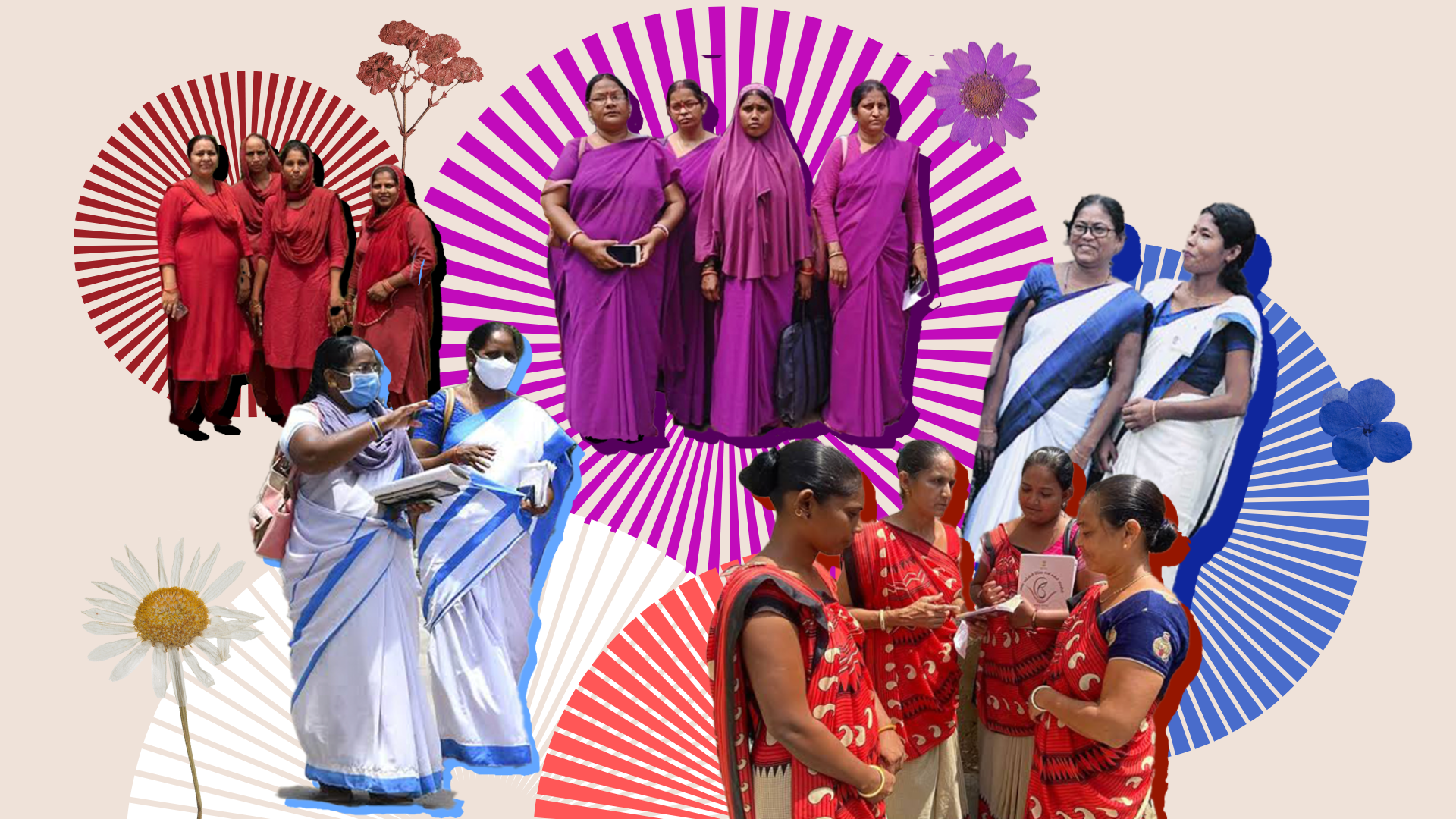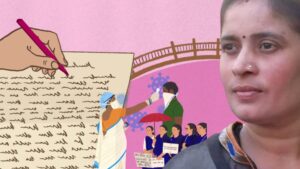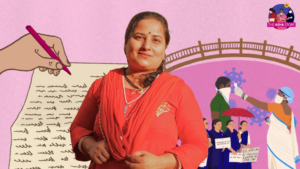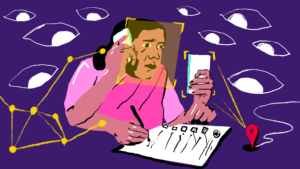An ASHA Worker’s ‘Vardi’: Sarees As a Symbol of Both Solidarity and Suppression
Uniforms are a path to social identity and status, but they can become an imposition when detached from women’s social contexts and needs

Lakshmi Kaurav has a fondness for two identical sarees in her cupboard, both coffee-hued (the sunlight lightens it to a rich maroon). Both have a plain cream-beige border, worn the same way every day, with the pallu draped neatly over the shoulder. This dress is her ‘pehchaan (identity)’ as an ASHA facilitator in Madhya Pradesh, she says.
The uniform saree’s colour itself changes across the state: in rural Sehore or Mundla Chhawal it is purple, in urban Gwalior or Indore it is a vibrant orange. But still, these six yards, folded and neatly draped, mark their social identity as frontline health workers, says Lakshmi.
The official mandate is to wear this on regular duty, while visiting the local public health centre for meetings or visiting pregnant women for immunisation. But to Lakshmi, this uniform is also an expression of solidarity among the 1 million women who make the Accredited Social Health Activist cadre in India. “We decided that whenever there is a protest or event, like a meeting with the chief minister, we will wear our uniforms, even if we aren’t on duty,” she says. “Yeh humari vardi hai (this is our uniform).”
ASHA workers have since 2012 pressed for the right to wear a uniform that establishes their social identity and weaves a path towards government recognition as ‘workers’. This recognition would strengthen their decade-long protest movement and in turn, guarantee a fixed salary, social security, pension benefits, and dignity of their labour, they say.
There is no Central guideline on the uniform to be worn by an ASHA worker, and the decision is made by individual state governments, either unilaterally or in consultation with unions to account for region-specific cultures and environments, union leaders told BehanBox.
But what is the ASHA attire? And what colour befits the affective labour of these women frontline workers?
The world knows ASHA workers as the ‘pink army’ since COVID-19, when they led India’s efforts in immunisation, surveillance, and raising awareness. But this image varies across the country. In Haryana, she is recognised for her red salwar-kameez; in UP, it is a white saree with blue borders; and in parts of Maharashtra, a taffy pink drape marks them apart. Meghalaya has blue jainsems (local traditional dresses); Andhra Pradesh has a white saree with red borders; and Assam’s white drape has a strip of green running across its borders.
There is social and political meaning in ASHA workers’ dress code, shaped over decades by medical and cultural contexts, says Bijoya Roy, an assistant professor of public health and gender studies at Centre for Women’s Development. And ASHA workers’ fight to own and be identified through a uniform has to be seen through these narratives, she adds.
Demand For A Dress Code
In 2005, the Ministry of Health and Family Welfare launched the ASHA programme under the National Rural Health Mission to improve delivery of rural healthcare services. With the mandate to ease the burden of Anganwadi workers and Auxiliary Nurse Midwives and provide last-mile healthcare, they were responsible in every village for immunisation, assisting women with prenatal checks and delivery, followed by ante-natal care.
There was no specification as to how these women should appear in society or what they should wear on the course of their duty; they were and remain to this date ‘volunteers’ expected to allocate a mere three-four hours of their day to this work.
The demand for a dress code escalated as their role expanded and responsibilities increased. Around 2012, some states, including Haryana, gave ASHA workers pink coats or jackets, recalls Sunita, an ASHA coordinator from the region. Continued protests over the next few years for a fixed salary also spotlighted a demand for sarees to become their official uniforms so that they could have a unique identity similar to Anganwadi workers (some states set down the saree as the dress code for Anganwadi workers in 2010, and now for their helpers too). The Odisha health department in 2016 decided on saree uniforms for multipurpose health workers like ASHA workers; Madhya Pradesh heeded their demands in 2017.
The frontline workers’ relationship with their uniforms have evolved since-Covid, when their sarees and ID cards were crucial in establishing their identity and value. “During Covid-19, we understood the importance of uniform. Earlier we visited houses and only met women; men or elderly people didn’t even realise that someone came to help us with health or give us information. Since COVID-19, ASHA workers’ identity has changed and the importance of uniform has increased,” says Netradipa, an ASHA facilitator from Maharashtra. Visual media coverage of their protests has also framed ASHA workers as ‘women in pink’.
At least three ASHA worker unions – including those from Maharashtra, Madhya Pradesh, and Bihar – have in the last two years written to the Central government to implement one uniform for their cadre. “You recognise a doctor from a white coat; a lawyer from their black robe; a police official from a khaki uniform. And one uniform will give an ASHA worker a distinct identity too,” Lakshmi says.
Colour As A Marker Of Solidarity
A uniform dress code brings “dignity and recognition to field-level workers”, the Odisha health department noted in its 2016 order. Sunita agrees the dress code has been instrumental in building their identity and legitimising the knowledge of women, who come from marginalised social and economic backgrounds, as health workers.
“Sab humein aam samajhte the pehele (everyone thought us common people earlier),” she says, but the dress code has created an identity and increased people’s trust in these women who work for the health department. “Now people see value in our work — be it giving polio vaccines or helping pregnant women with delivery.”
In a 2021 paper on ASHA workers and the sociocultural economy of healthcare, scholar Christa Whichterich argued that sarees as a uniform respond to a desire to “shape their identity as a particular of working women”. Bijoya says that for women workers, wearing a specific uniform highlights the labour that goes into performing skilled and complex tasks like drawing blood or data entry, but are still seen as ‘unskilled workers’, and uniforms help them gain respectability and acceptability from the government and community alike.
The workers consider any attack on this uniform as an attack on their identity: last year, there was backlash against a police official in Telangana who manhandled and slapped an ASHA worker, also pulling her saree. A similar instance sparked protests in 2017 in Morena, Madhya Pradesh. Lakshmi, along with other ASHA workers, led a protest against this incident.
“We were able to show our pride over our uniforms for the first time. We made an issue and the Morena collector had to come and apologise,” she says. The collector reasoned that both, the police and ASHA workers, wear government mandated uniforms and both should call for respect, Lakshmi recalls.
The uniform has also played a role in strengthening their protest movement and rooting their identity within the community over the years. “When we wore different colour sarees, reporting of our protests didn’t carry as much weight because they couldn’t recognise us,” says Sunita of the media response to the ASHA workers stir. “Sari ki vajah se aaj humein voh pehchaan mili ki agar aaj ASHA ka andolan hain, toh media, police, community, sab jaante hain (our agitation drew media attention when it was identifiable by a uniform saree).”
But arbitrary colour variations across states and within the ASHA cadre also tends to create hierarchies. In national protests, women automatically segregate into their regional factions: if you’re wearing purple, you must be from Madhya Pradesh. Pink? You should sit with women from Maharashtra. “Voh udhar ladh rahe hain, hum idhar. Agar ek jaisi uniform mein hain, humare mann mein aayega ki hum milke ladh rahe hain (the fight is splintered because of these colour differences),” Netradipa says.
Some states create further colour codes for workers in different settings, sharpening the potential divide. In Madhya Pradesh, for instance, an ASHA facilitator wears a coffee-colour saree; orange is reserved for an ASHA worker from urban areas and purple for ASHA workers from rural areas. Lakshmi says this has the effect of creating unnecessary ill-feeling and animosity: an urban ASHA worker looks down upon rural counterparts, a rural ASHA worker sees an ASHA coordinator with ambiguity.
Politics Of Colour And Clothing
Healthcare is colourcoded – the blue curtains, the white coats, colour gradations that demarcate identities of clinical workers, community workers, paramedics and patients.
“Colours and attire in healthcare didn’t originate in our context,” says Bijoya, explaining that India draws references to other contexts like that of the UK’s National Health Services..
ASHA workers share many similarities with those engaged in nursing jobs – both shaped by gendered division of labour, political economy of care work, and seva, wrote Christa Whichterich. Caregiving, as women’s work first and polluting work second due to Brahminical norms and colonial concepts, attached notions of impurity to work that involved close contact with body and bodily fluids. Christian missions made nurses uniforms starch white to “counter stereotypes of impurity and permissiveness” and “added notions of nobleness and discipline” and self sacrifice, like nuns.
The pink that ASHA workers are now associated with – also the colour assigned to pediatric workers in many healthcare systems, per Bijoya – allowed the cadres to push back against the discrimination they faced as ‘impure’ workers in hospitals and dispensaries, according to Wichterich.
In the paper The Making of Work and Good People, researcher Krithi Ramaswamy adds how Hindu political thought during the Independence movement, shaped by both Hindu and Christian religious, ideas provided a framework for the ‘seva’ that ASHA and Anganwadi workers do today, a “pious mode of care, with religious and ascetic undertones, hinged on an idea of serving the nation selflessly”.
The iconography of Bharat Mata in a saree, created during the national movement, reinforced the image of the Indian woman. Read in with early policy documents that encouraged married women to enrol in for the ASHA programme, it reinforces the idea that only women who subscribe to Savarna-patriarchal values have the right to do seva for the family, children, and community. The Indian government “mobilised the idea of seva” to construct the image of an ideal ASHA worker, added Krithi.
But, in her interviews with ASHA workers, Krithi found that the women were breaking away from this idea of seva as self sacrifice by ‘placing the self within the contours of service’. They began to see their labour as work “deserving of “recognition and compensation”, she wrote. Over the last two decades, she found, ASHA workers had begun to frame their identity through their bonds with their family, each other, and the women in the community.
Hierarchy Of Clothing
There is a hierarchy within dress codes in healthcare: who is skilled, who is more close to the doctor, who is a community worker, who is a facilitator, and in the Indian context, who belongs to which caste.
Take the colour blue. In Tripura in 2019 and in Bihar in 2023, ASHA workers protested against having a blue uniform. “How is my dress the same as a sanitary worker?” bellowed one angry ASHA worker from Bihar. A majority of ASHA workers hail from marginalised caste backgrounds but objections to a blue inform reveal the degree to which caste dictates the worth of labour.
“Blue, when read within the context of the Dalit Adivasi movement, represents non-discrimination – under the sky, everyone is believed to be equal,” says Bijoya. However, the Bihar ASHA workers protest “reflected deeply embedded caste hierarchies across job categories.”
Not every ASHA worker finds the saree comfortable or convenient. They can be restrictive in the field, Netradipa says. ASHA workers travelling in remote or hilly regions have challenging commutes in weather conditions ranging from heavy rains to cyclonic storms. “There is always the tension of managing your pallu, while also holding on to your bag, diary, umbrella,” says Netradipa, recalling instances where women travelling with her fell from their cycles while trying to juggle their belongings.
By overplaying the saree code, the government is “dictating” the image of an ideal community health worker, Bijoya says.
Incomplete Token of Recognition
State governments give ‘non-monetary incentives’ to ASHA workers that cover their uniform, diary, cycle, mobile phones, and ID cards. But these are not enough for them to meet actual expenditures some of which then are personally borne by ASHA workers.
In Haryana, the allocation of Rs 1,500 (increased from Rs 1,000) is enough for a saree but not the salwar kameez, the preferred dress code for ASHA workers in the region, says Sunita. The amount barely covers the cost of two suit materials, and does not account for the cost of dupatta and the final stitching cost. Even for a saree, it is not enough to buy a petticoat or material for a blouse and get it stitched. Moreover, protective gear like a jacket, mask, and sun coat “are part of our duty and should be seen as a part of our dress code too, a factor which the government currently neglects”, she adds.
Similar grievances were voiced by Bihar ASHA workers in 2023, who demanded from the government “full dress instead of a single saree, that must include blouses, petticoats, and woollen jackets etc.” In Maharashtra, ASHA workers objected to the state government’s decision of reducing dress code honorariums from Rs 1,200 to Rs 600. Budget cuts in uniform allowance have elicited criticism from ASHA and Anganwadi worker unions in the past. In Puttur last year, Anganwadi workers and helpers complained of “low-quality” sarees that were in tatters after less than 20 days of use; those in Uttar Pradesh were concerned about making one saree last a whole year.
Some see dress codes or honorarium as a bandaid solution on their large wound of precarity and systemic devaluation of their labour in the public health ecosystem. Attached to a uniform is the official recognition of one’s employment status, but till date we haven’t received that recognition or dignity, says Noni, an ASHA worker from Dirubhanga, Assam. To Noni, her white ‘vardi’ is a sobering reminder of a rightful recognition. “They can make us work, but not pay salaries. So what is the point of uniforms?”
Bijoya agrees. The Gujarat government in 2017 implemented the saree dress code in response to protesting ASHA workers, in what media reports called a ‘post-poll gift’ to appease the frontline workers. In 2022, Karnataka Anganwadi workers refused to wear sarees because it “looked like a banner” and had the logo ‘POSHAN Abhiyaan’ printed on its borders. “The workers were just handed a sort of uniform—they weren’t even consulted,” says sociologist Poorva Gultai.
Sunita explains that while dress codes are at times decided in consultations with ASHA worker unions, it is the men in positions of power, often unaware of the cultural contexts and challenges of ASHA workers, who take the final call. “Kya comfortable rahega auraton ke liye — aadmi log yeh decision nahi le paate hain,” she says. ASHA unions such as those led by Netradipa have written to the central government to expand the definition of uniform: ASHA workers should have the choice of wearing a salwar kameez or a staff apron that saves time and favors comfort.
A dress code makes us feel like we’re part of the health department, the community, and of a movement bigger than us, says Netradipa. Her beaming pink saree gently nourishes their collective voice and articulates a question for policymakers: ASHA ko ek kaise banaya jaaye. “If we have been recognised as global health leaders, it is our responsibility but also the government’s to recognise us in a dignified way – be it through a dress code or regularised incentives – such that it builds our unity and collective strength,” she adds.
This post previously identified Bijoya Roy as Bijoya Biswal. The error is regretted.
Did you hear about The ASHA Story, the feminist archive we are building that documents the story of ASHA workers? You can contribute to it too. Write to us contact@behanbox.com.
We believe everyone deserves equal access to accurate news. Support from our readers enables us to keep our journalism open and free for everyone, all over the world.




